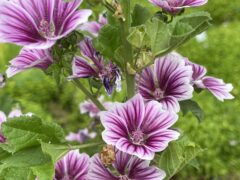
Apple
Malus domestica
Semi-dwarf and dwarf apple trees can grow from 8 to 15 feet tall and produce … Continued
Drought-tolerant and drought-resistant plants may still need supplemental water from time to time, but they can survive periods of dryness without dying.
Drought-resistant plants like cactus, hens and chicks, and sedums can go for very long periods without water and do not tolerate poorly drained locations. Drought-resistant tropical plants grown indoors in winter like cactus, Sansevieria, Echeveria, and other succulents sometimes fail due to overwatering.
Drought-tolerant plants grow in many textures and sizes and have different adaptations that help them get through periods of drought:
The latter two types of plants are drought tolerant once established because any new planting, regardless of drought tolerance, needs to be watered during the first growing season to allow roots to reach the depths needed to access moisture during dry periods.
It’s also important to note that survival may not mean that the plant will look its best during this time. Watering weekly for a longer period of time will result in the best-looking gardens with the highest tolerance for drought. During the hottest, dryest times in summer, watering deeply twice a week is recommended. These less frequent waterings will encourage root systems to expand, making it easier for plants to access moisture when their environment is dry.
Winter drought has become a bigger problem in recent years as snowfall declines. Evergreen plants are especially vulnerable during winter drought because their foliage continues to shed moisture while dormant deciduous plants have shed their leaves and can conserve moisture in woody stems and underground. Watering shrubs and trees in winter on days when the temperature allows (above freezing) will help ensure their healthy return in spring.
Here are some drought-tolerant and drought-resistant plants to grow—

Malus domestica
Semi-dwarf and dwarf apple trees can grow from 8 to 15 feet tall and produce … Continued

Malus hybrids
A genus of about 35 species of deciduous trees and shrubs from Europe, Asia and … Continued

Malus ioensis
This small native tree has spreading branches and a broad, open crown and sometimes grows … Continued

Malva sylvestris 'Zebrina'
A super tough perennial with soft pink flowers lined striking, raspberry-purple veins. 2″, bowl-shaped blooms … Continued

Manettia luteorubra
Small, bright red blooms tipped with gold look just like candy corn candy! A vigorous … Continued

Mazus reptans
This low-growing, mat-forming perennial features rosettes of lance-shaped toothed leaves spreading quickly and blooming from … Continued

Melissa officinalis
Leaves have an almost metallic golden sheen. Otherwise similar to standard lemon balm with lemony … Continued

Mentha arvensis
Tiered clusters of small white flowers open along stems in summer and continue through fall, … Continued

Mentha (assorted)
‘The Best’ (Mentha spicata), like other spearmints, has less menthol than peppermint varieties which make … Continued

Mirabilis jalapa
An heirloom garden standard grown as an annual, these colorful antiques will self-seed and return … Continued

Miscanthus sinensis 'Bandwidth'
Broad, bright gold bands running along the length of rich, green leaf blades. Useful as … Continued

Miscanthus sinensis 'Gracillimus'
Blooms with a massive display of copper-colored flowers in late summer. The seedheads age to … Continued